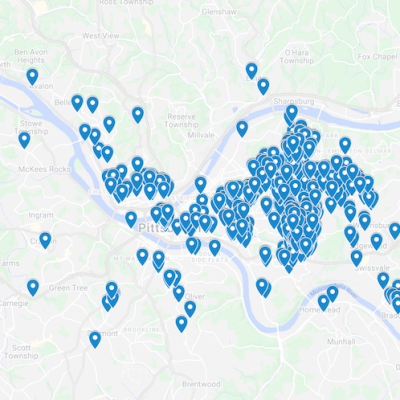
Bloomfield is a neighborhood in the East End of Pittsburgh. The area was annexed into the city in 1868 as part of Peebles Township and was initially developed between 1870 and 1905. Its early residents were German immigrants who worked at industrial sites in nearby Lawrenceville. In time, the German population gave way to Italian immigrants.[1]“An atlas of the Bloomfield neighborhood of Pittsburgh 1977,” (online—Historic Pittsburgh).
Although never a primary site of Jewish settlement, Bloomfield attracted many Jewish families in the early 20th century, possibly due to its proximity to emerging Jewish centers in Squirrel Hill and the East End and to the ease of travel along Bigelow Boulevard. In the late teens and early 1920s, there were as many as 115 Jewish households living in the “Bloomfield District” encompassing the present-day neighborhoods of Bloomfield, Garfield and Friendship. Approximately 75 of these households were affiliated with Rodef Shalom Congregation. The rest were split between the relatively new B’nai Israel and Adath Jeshurun congregations in nearby East Liberty and the older Tree of Life and Poale Zedeck congregations in the Hill District and Oakland.[2]Pittsburgh Jewish Community Book, 1921 (online—Historic Pittsburgh). From 1922 to 1932, Bloomfield also had a small local congregation called Aves Achim (Brotherly Love).
The Jewish population of the Bloomfield District remained stable for decades. In the late 1930s, there were approximately 150 Jewish households in the district. In the early 1960s, the Jewish population had declined only slightly to around 135 households but had shifted toward the southern edge of the neighborhood, along its border with Shadyside.[3]Kuntz, Leonard Irvin, “The Changing Pattern of the Distribution of the Jewish Population of Pittsburgh From Earliest Settlement to 1963.” (1970). LSU Historical Dissertations and Theses. … Continue reading
References
| ↑1 | “An atlas of the Bloomfield neighborhood of Pittsburgh 1977,” (online—Historic Pittsburgh). |
|---|---|
| ↑2 | Pittsburgh Jewish Community Book, 1921 (online—Historic Pittsburgh). |
| ↑3 | Kuntz, Leonard Irvin, “The Changing Pattern of the Distribution of the Jewish Population of Pittsburgh From Earliest Settlement to 1963.” (1970). LSU Historical Dissertations and Theses. 1864. (online—LSU Historical Dissertations and Theses). |